There are very many pruning varieties! As far as the cognac region is concerned, the Guyot and the Cordon de Royat are the most important. The Guyot is often a double Guyot and it can be tied horizontally (‘à plat’) or arched (‘en arcure’ or ‘en arcure haute’). There is also a small chance you might still come across the Globelet. All pruning shapes are in principle allowed, but it is a legal requirement that pruning is done every year.
When the vines have become very old, it sometimes becomes difficult to prune a well-recognisable shape. After about 40 to 50 years, vines are often pulled up and replaced by new ones, usually after the land has lain fallow for one or two years.
Pictured below is a Guyot double and arcure haute.
Classifications
To begin with, pruning shapes can be classified by length (long versus short), stem pruning versus spur pruning, high or low.
High or low.
Speaks for itself. The choice between these has implications for the efficiency of maintenance and picking, i.e. can you reach it well or not. It also affects the effect that heat radiation from the ground (in summer) and frost from the ground (in winter) has on the plant.
Long or short.
This says something about the length of the branches one grows and especially the number of eyes on them.
Stem pruning versus spur pruning.
Stem pruning means that there are no permanent branches, all but one of the strongest biennial wood is pruned away. Only the trunk is older than one year, but otherwise the bearing branch is the oldest and it is never more than one year old.
Spur pruning means that there is no annual replacement of the bearing branch. So the bearing branch is older than a year and often thick and gnarled.
The globelet form is a short spur prune form. In principle, the globelet can be grown both high and low, but in practice it is almost always low. A number of main branches grow from the trunk, pointing upwards like the fingers of a hand, as if you could place a cup in it (globelet = cup). In southern Mediterranean countries, it is still common. There it is warmer and there is significantly less chance of frost damage.
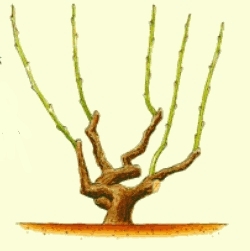
The cordon form, called cordon de Royat in full, is named after the town of Royat in the Puy-de-Dôme department. It exists in a single form, cordon simple, and a double form, cordon double, which simply means it has one or two ‘brancares’ (branches). The branches of the cordon de Royat are permanent. The spurs of these canes or cordons are pruned back to two or three eyes every year. New twigs grow from these eyes to form bunches. This form therefore also belongs to the spur pruning type.
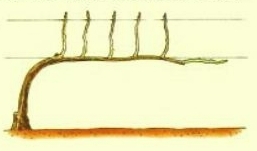
A Cordon simple is shown on the left. Annually, only the vertical shoots are pruned away. The lcordon therefore becomes thicker and woodier every year.
The Guyot form is named after the 19th-century French physician Jules Guyot, who published about it in a journal in 1860. The pruning form is very similar in appearance to the cordon form, but the cordons are pruned away every year. It is therefore a form of stem pruning.
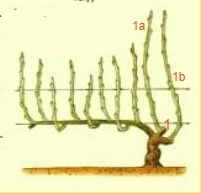 Here on the left is an image of a Guyot simple. Annually, the entire cordon, growing vertically to the left here, is pruned away. Two shoots have also grown from the renewel spurs (1). The upper one, so here the middle one (1a), becomes the new cane or cordon and the lower one (1b) is pruned back to two eyes and becomes the new renewel spur.
Here on the left is an image of a Guyot simple. Annually, the entire cordon, growing vertically to the left here, is pruned away. Two shoots have also grown from the renewel spurs (1). The upper one, so here the middle one (1a), becomes the new cane or cordon and the lower one (1b) is pruned back to two eyes and becomes the new renewel spur.
So how does such a Guyot or cordon form?
The first year the vine is planted, in early May. One or a few branches may already be growing on it (picture bottom left). These are pruned off immediately, leaving one branch with two or three eyes (bottom right image).
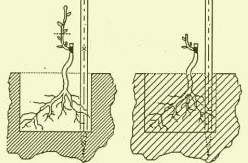
That summer, some branches will start growing out of the vine again (pictured bottom left). In July, these will be topped at about 1.5 metres (just below the top wire). These are pruned away in winter, except for one nice branch that remains 60 cm high (to just below the lower wire; centre image: of what is pruned away, the leaves are turned white). On this, 3 eyes are kept at the end. This branch will be guided along the vertical pole and become part of the vine’s trunk (bottom right image).
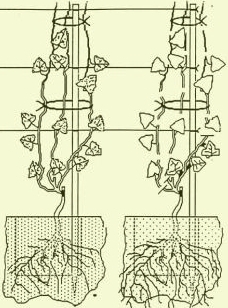
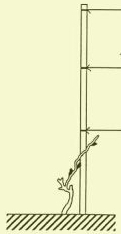
In the spring and summer (of the second year), several shoots grow out of this again (picture below left). The best three to four of these are also topped again later in the summer just below the top wire. If you want a Guyot-simple then, when pruning in February-March of the third year, the best two are kept: a longer one with five buds, the tallest, and a short one with two buds on it (picture bottom right). The longer one will be the cordon or cane and it will be led vertically on a warm day. From the short one, two shoots will sprout, which will serve as both cane and renewal spur the following year.
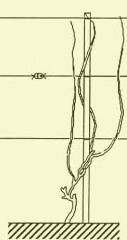
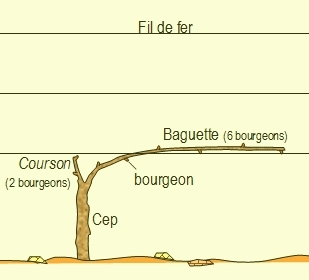
In contrast, if you want a Guyot double, you keep three shoots. Two are pruned long with five buds and the bottom one short, with three buds. The two longer ones become the laying branches (cordons).
In the summer of that third year, shoots grow from the canes and are guided upwards (bottom left image), from which the grape bunches will emerge (bottom right image).
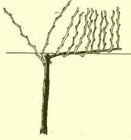
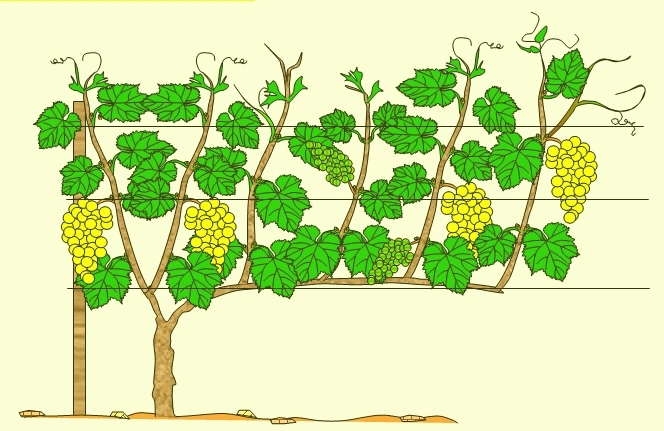
After these first three years, the shape is there. The ‘taille de formation’ is realised. In the following years, the ‘taille de fructification’ takes place. The cane that has borne fruit (pictured bottom left: 1) is pruned away in its entirety (1a). Two new canes have emerged from the renewal spur. The upper one (2) becomes the new cane and the lower one (3) is pruned back at two eyes (3a) to become the new renewal spur. Below right is the image showing the result.
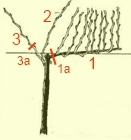
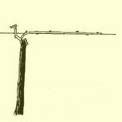
Incidentally, it is also possible to alternate each year between growth to the left and to the right. This is also the principle of the Guyot-Poussard (see below). Two branches are kept: one branch with a cane and a renewal spur (the right branch in the picture) and a short branch with only a renewal spur (the left branch). This alternates left and right each year.
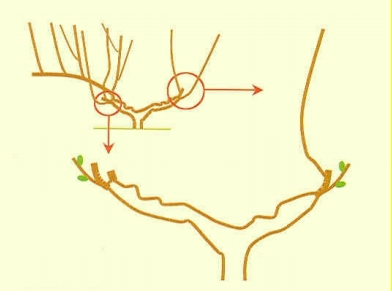
Finally, variations such as a double Guyot-Poussard are still possible.
Apart from pruning the shape, described in detail above, much more pruning takes place: suture trunks are pruned away, shoots arising in the axils of leaves (gourmandes) are cut away. Many buds and leaves are also pinched away (squeezed out) or ebourgeoned. The shoots that are allowed to continue growing are usually budded at a certain length. The number of bunches that are allowed to grow is also greatly restricted by simply cutting away a number of bunches early on. All this pruning ensures that only 1 or 2 bunches grow per branch, but above all that all the juices can go to these few tendrils and bunches so that they become strong and large and produce grapes with lots of flavour. Without these measures, you get a grapevine with small grapes that remain sour.

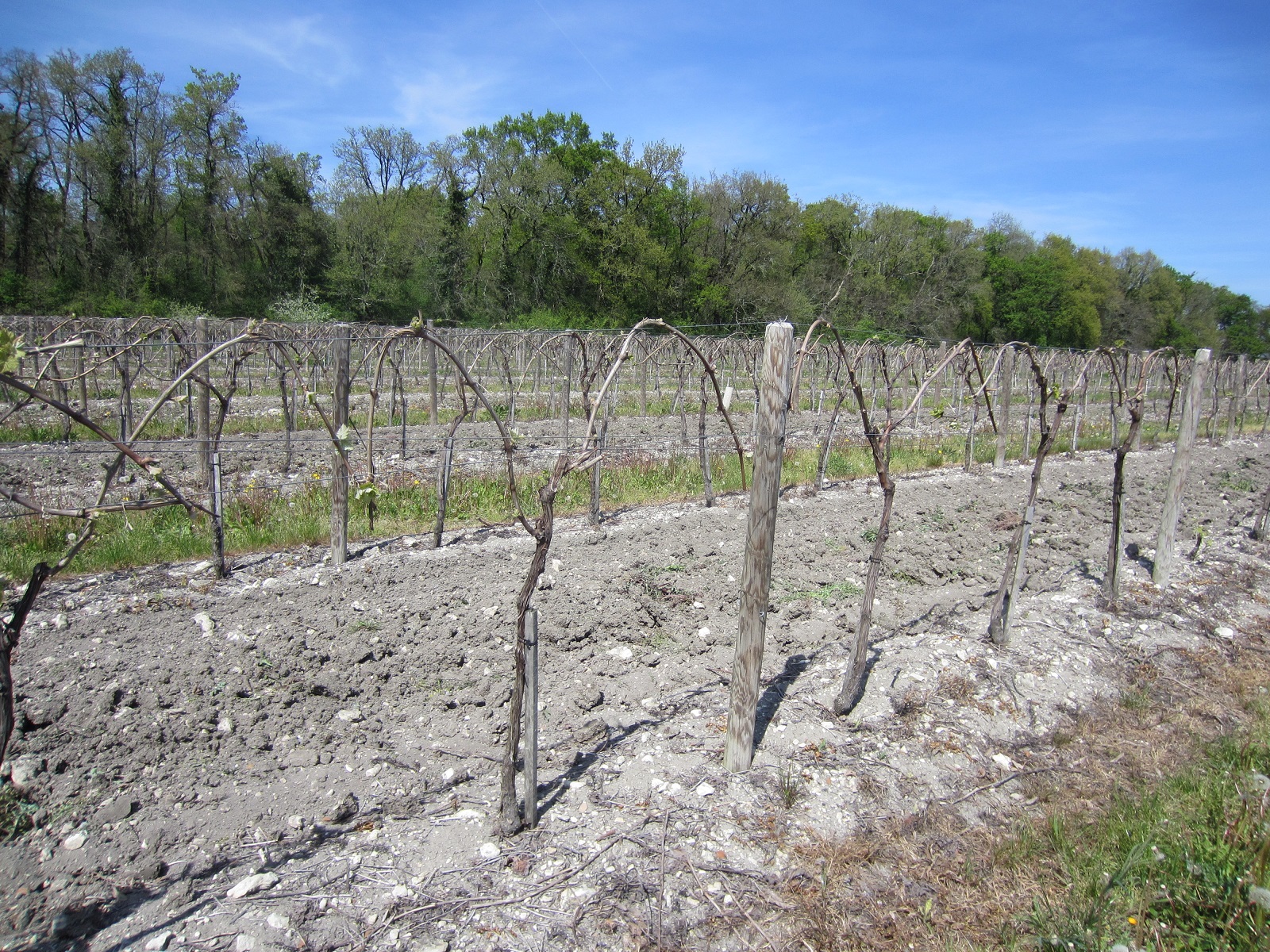
Comments
Forms of pruning — No Comments
HTML tags allowed in your comment: <a href="" title=""> <abbr title=""> <acronym title=""> <b> <blockquote cite=""> <cite> <code> <del datetime=""> <em> <i> <q cite=""> <s> <strike> <strong>